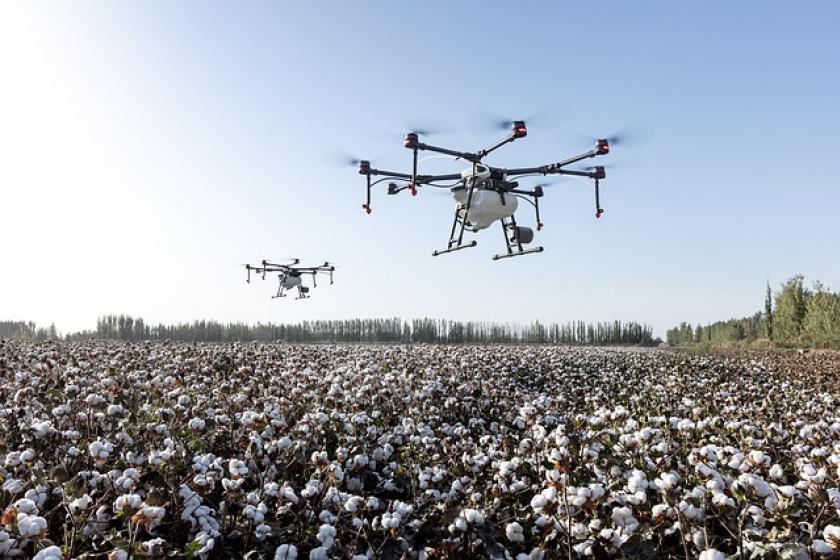The Future of Innovation: How 5G Is Pushing Drone Technology Forward
The ultra-reliable, ultra-low-latency, and high-bandwidth communication links afforded by 5G networks offers a way to support safe and innovative applications for drones.
April 15, 2022

Ever since drones took to the skies, they have become a popular commodity among content creators, hobbyist pilots, or innovators wanting to take this futuristic technology to new heights. Beyond consumer applications, businesses and the public sector also have leveraged drones in several ways, from supporting search and rescue missions, facilitating infrastructure inspections and delivering medical supplies, and improving access to healthcare in remote communities. – drones have become a beneficial means to supporting communities, businesses, and people.
Now, trials are expanding, and regulators have been giving the green light opening the gates for widespread adoption and unlocking the growth of drone technology to uncover new innovations and benefit people in countless ways.
What’s next for drone technology? One way to unlock even more potential is via 5G networks’ ultra-reliable, ultra-low-latency communication links, which are pivotal to the search for new and safe ways to use drones. Thanks to public-private cooperation, 5G rollout continues throughout the UK, the U.S., and other countries around the globe.
Small drones solving big problems
When it comes to safely coordinating drones to perform a task, private 5G networks will be key to providing reliable communication links between them. With the combination of low latency, high speed, and massive capacity 5G network paired with edge computing, controllers can command drones in near real-time with fewer dropped links. That means, among other things, less loss of control and fewer mid-air collisions.
Data is food for AI, and a lot of drone use cases are around collecting data as opposed to sending people up to survey dangerous telco poles or waiting post-flight to download vital data. Already out in the field, researchers are testing how the right mix of 5G, mobile edge compute, and AI can help drones detect, interpret, and respond to changing weather conditions. Quality data can be sent through the edge layer in the network to create faster images or provide real-time data to emergency crews responding to fires.
A 2014 MIT study showed that the human brain can process an image seen for as little as 13 milliseconds (ms). Talk about low latency! It’s what allows us to safely throw and catch, drive cars, cut food, and much more.
With drones, the goal is to be as fast as the human brain is at processing visual information. That allows operators to see and react to things in real-time. For instance, if a drone is flying at 25 mph, a 100 ms delay means the drone has traveled about three feet before the operator sees the video. Three feet could easily be the difference between an accomplished and failed task or a successful flight and a crash.
A connection to a 5G network means a drone can send information back to base in real time. Early drone technology meant all the information from drone-mounted cameras, sensors and telemetry could only be uploaded from the drone’s hard drive once it had landed. A 5G connection changes all that and opens up new possibilities.
Beyond that, a longer delay means operators can't fly the drones too quickly, which means tasks like scanning agricultural fields take longer—or, with something like searching a forest fire to find injured people, too long.
Developers often employ tactics like increasing the frame rate and compressing video to reduce latency. The strength of the network, however, is what determines the time of transmission and puts a ceiling on how quickly data can be transmitted.
Existing 4G networks offer an average latency of approximately 50 milliseconds. 5G networks, on the upper hand, should clock in around 10 milliseconds.
5G-enabled drone technology is just getting started
Better download speeds, food delivery, and even helping first responders fight fires to save lives are just scratching the surface of what 5G-enabled drone technology can accomplish. Other applications include:
Drones over 5G can help address food insecurity. By inspecting crops and feeding the data directly to those working on the ground, they can guide a tractor precisely to the spots where it needs to spread fertilizer.
Drones over 5G can bring medical supplies to those living in underserved or hard-to-reach places. They can overcome last-mile challenges and deliver much-needed healthcare, from medicine in Tanzania to medical test results in remote parts of Virginia.
Drones over 5G can even be used to deliver 5G. Programs in places like California and Hawaii are perfecting drones’ ability to supply 5G connectivity.
And the list goes on and on.
On their own, 5G and drones are both exciting technologies. Combined, the innovations they unlock and the benefits they bring to people around the world are nothing short of staggering.
When it comes to 5G-powered drones, the sky really is the limit.
Adam Schink is Senior Manager of Innovation & Scouting at BT Global.
Related articles
Read more about:
5GAbout the Author
You May Also Like


